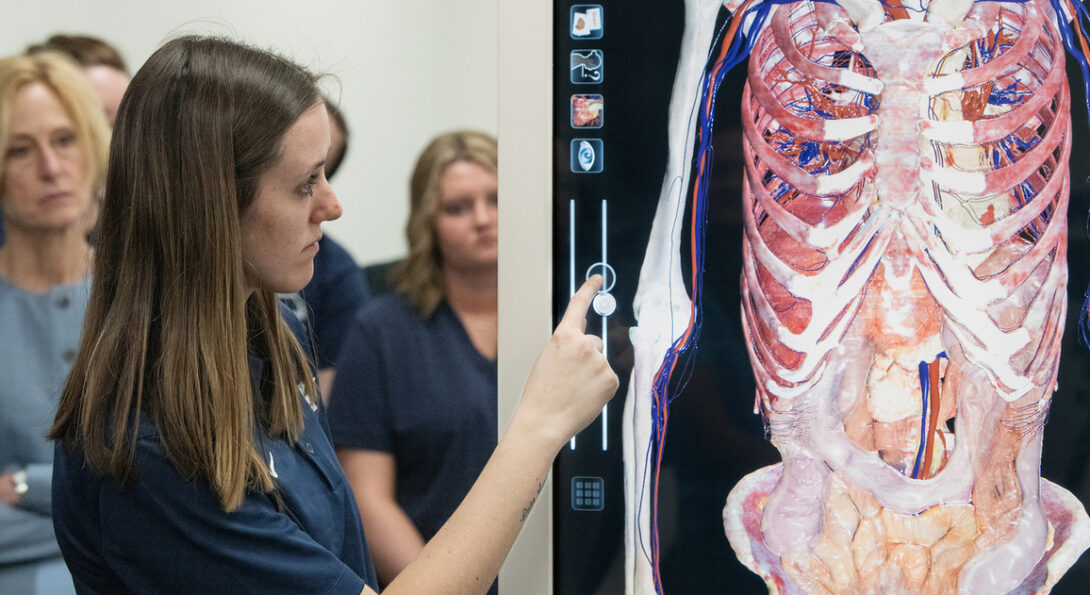Memorial Health donates two Anatomage Tables to Springfield campus

Text of the story Heading link
The UIC College of Nursing’s Springfield campus and the University of Illinois Springfield unveiled two Anatomage Tables on April 15.
The high-tech tables, donated by Memorial Health, will allow students to use the interactive and immersive tool to visualize human anatomy as they would on a cadaver.
In addition to UIC Nursing students, the new technology will be used by UIS students who are studying athletic training, biology and exercise science, as well as by pre-nursing students (freshmen and sophomores at UIS who are preparing to enter the nursing program as juniors).
“The Anatomage Tables give students hands-on experience doing virtual dissections and help them develop skills that are important in the workforce,” says UIS Chancellor Janet L. Gooch. “We greatly appreciate Memorial Health for its strong community support and commitment to educating the next generation of health practitioners.”
text of pull quote Heading link
Memorial is excited to work with UIC and UIS to ensure the long-term success of the UIC Nursing-Springfield program. This dynamic nursing education program is making it possible to educate more young people interested in practicing nursing in central Illinois.
| CNO Emeritus, Memorial Health
body copy 2 Heading link
The donation of the tables builds on a 10-year partnership formed between UIS, UIC Nursing and Memorial Health for the purpose of launching a nursing program in Springfield, with the first cohort of nursing students enrolling in 2016. Over that time, Memorial Health has donated nearly $8.5 million to secure faculty, enhance clinical learning spaces, and has provided scholarship support of approximately $4.5 million to students aspiring to a nursing career.
“Partnerships like this one benefit not only Memorial Health, UIS and UIC Nursing, but the entire central Illinois region,” says Ed Curtis, president and CEO of Memorial Health. “The steps we are taking now will ensure Memorial and other health care organizations can continue caring for local residents in the decades to come. We’re pleased to have both UIS and UIC Nursing as partners in this important work to improve the health of the communities we serve.”
Diving deeper Heading link
Sara McPherson, PhD, RN, CNE, director of UIC Nursing -Springfield, says the tables will be useful in anatomy and physiology I and II, both pre-nursing courses, as well as the nursing courses pathophysiology and pharmacology.
“As we study disease processes, the Anatomage Tables will allow us to dive deeper and show students where problems occur in the body or what organ damage occurs from them,” she says.
Dissecting human cadavers is not typically a part of the nursing curriculum, so the life-size virtual dissection tables will allow instructors and students to interact with 3D images of anatomy with touch-screen technology.
“This table will help us bridge the gap between clinical and didactic coursework, just being able to visualize and break down the levels of anatomy while looking at the physiology of a virtual patient,” says Christian Geronimo, a UIC Nursing – Springfield BSN student.
Marsha Prater, PhD, RN, NEA-BC, CNO Emeritus, Memorial Health, says the healthcare organizations are one of the biggest employers in Springfield and the surrounding region. While there are shortages in many healthcare disciplines, the registered nurse workforce is deeply affected, she says. Educational resources like the Anatomage Tables are an important tool to recruit and engage students to join the health sciences.
“Technology is so engaging for a learner,” Prater says. “To be able to see 3D images of the body, to see the connections, it’s really quite eye-opening and enables learners to get excited about the complexity of the human body.”
McPherson says instructors will be able to change the gender, age and condition of the “patient,” allowing students to see a multitude of case studies. The tables will supplement learning taking place in the simulation lab with simulated patients, she adds.
“Depending on what condition or disease process our simulated patient has, we can look at it with the Anatomage Table,” McPherson says. “We’ll be able to see both angles: what the patient presents like on the outside, and what’s actually happening inside the patient.”
University of Illinois Springfield and UIC Nursing contributed to this report